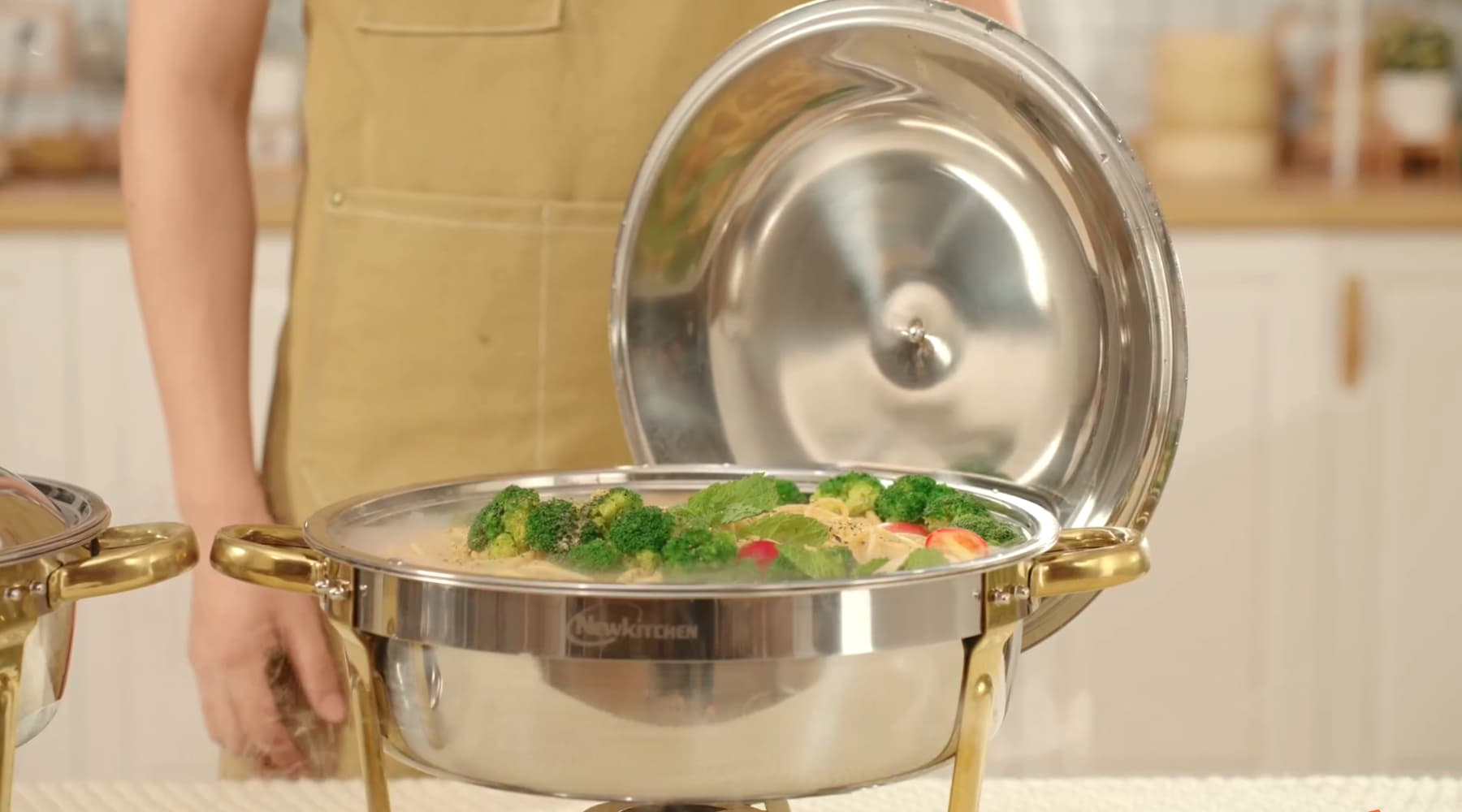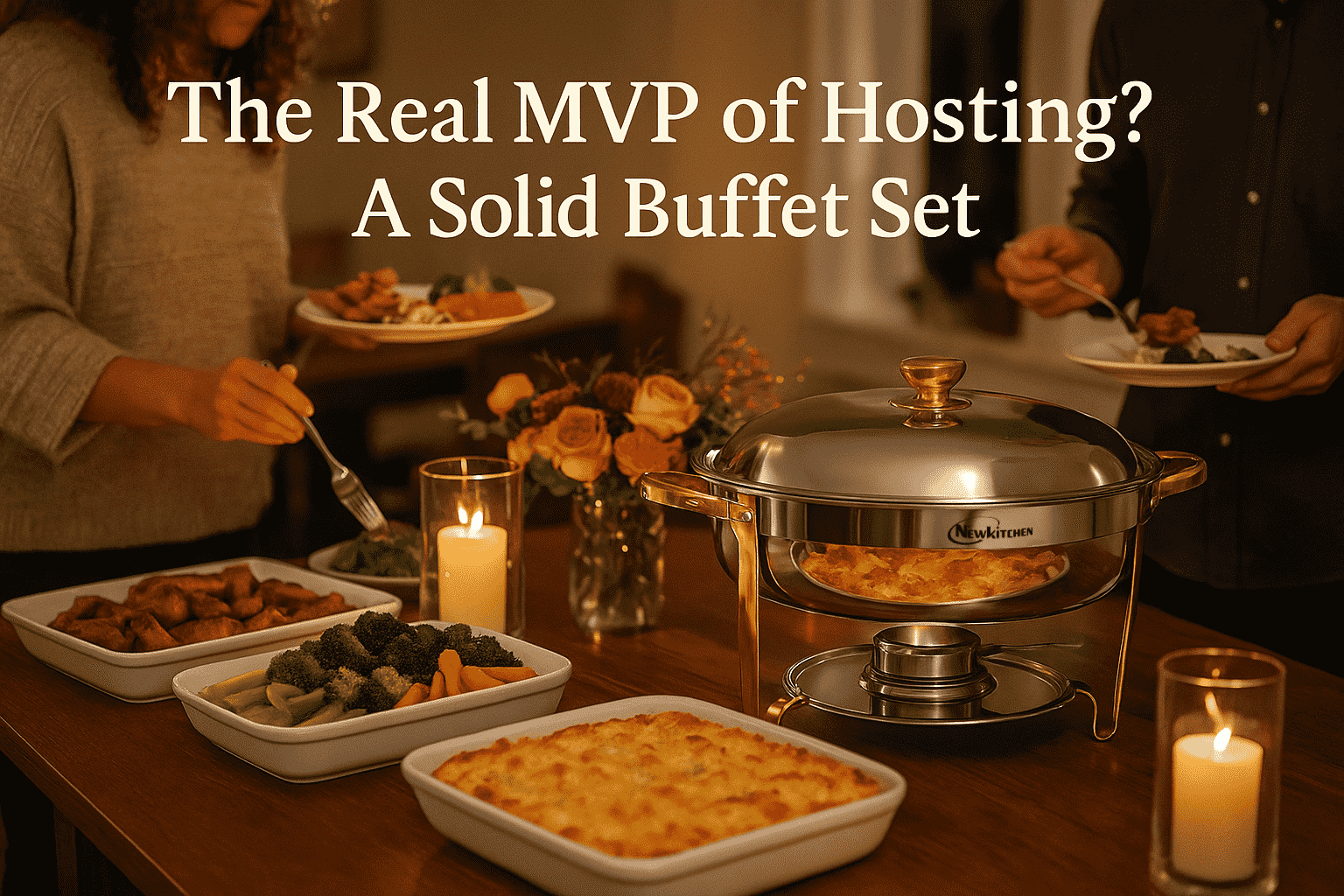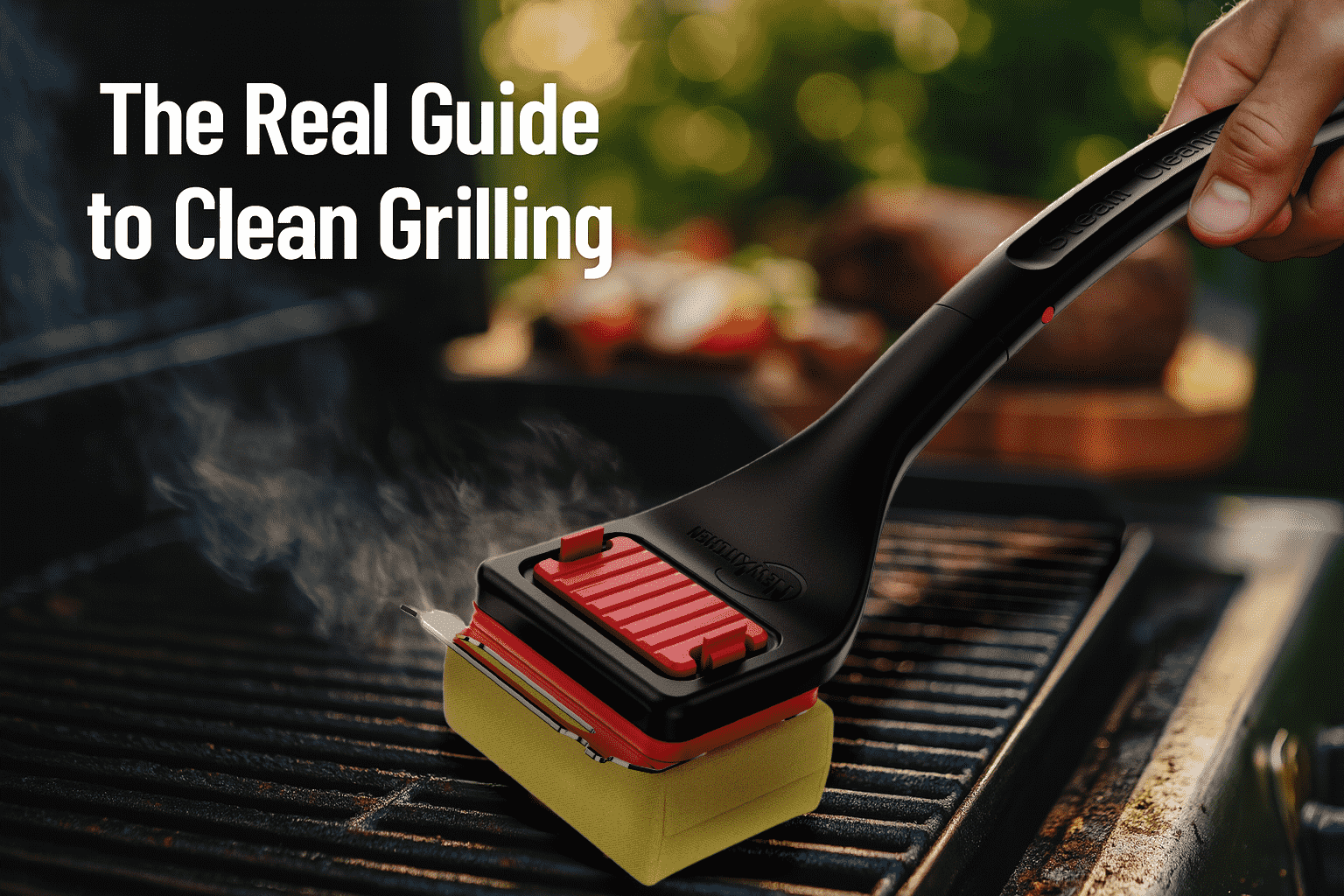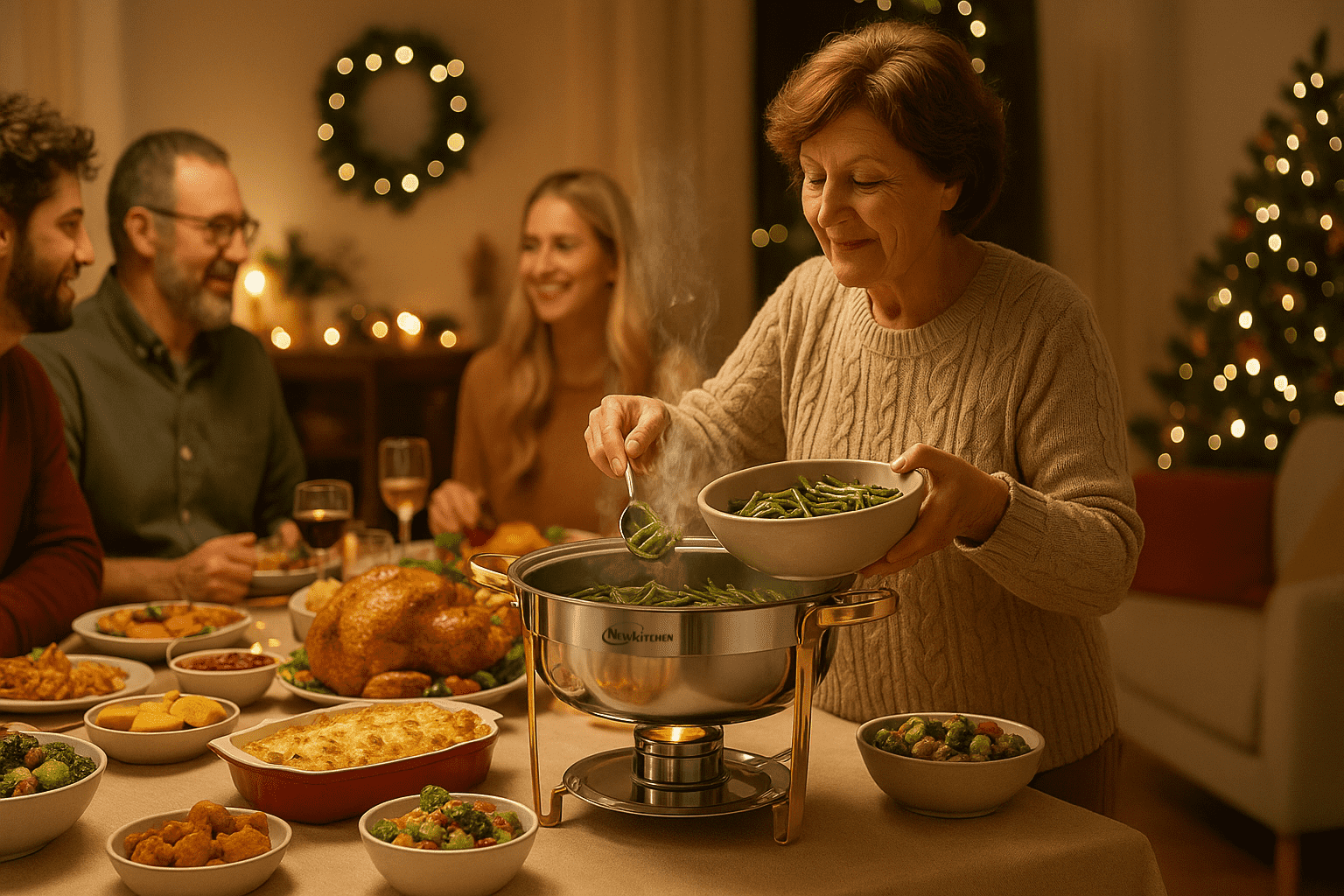Picture this: you’ve spent hours prepping a spread for friends and family, and the last thing you want is half the dishes teetering between cold and scalding. That’s where a solid chafing dish setup comes in—it’s the unsung hero of any self-serve feast. In this post, I’ll walk you through the top eight questions I always get asked: from “Which chafing dish brand should I trust?” to “Do I really need to fill the bottom with water?” By the end, you’ll know exactly what to buy, how to use it, and why it’s a game changer for everything from backyard barbecues to office potlucks.
Table of Contents
- What is the best brand for chafing dishes?
- Are chafing dishes worth it?
- How do you use a chafing dish buffet set?
- What is the difference between a chafing dish and a bain-marie?
- How many chafing dishes for 100 guests?
- How many people will an 8 qt chafing dish feed?
- What is the best fuel for a chafing dish?
- Do you put water in the bottom of a chafing dish?
1. What is the best brand for chafing dishes?
Let’s be honest—“chafing dish” isn’t the most glamorous item on your shopping list, but getting the right one makes hosting so much smoother. Brands differ in build quality, price, and what features they throw in. Below, I’ll walk through a few heavy hitters and, yes, I’ll start with our own NewKitchen 6 QT model, because it really does tick so many boxes.
1.1 NewKitchen’s 6 QT Chafing Dish (Why It’s My Go-To)
-
More Room for Food
Most standard chafer sets top out at 5 QT, but ours is a full 6 QT (roughly 5.7 L). That extra liter means you won’t be refilling as often—especially nice if you’re serving hungry crowds. - Three Modes in One
-
- Keep Warm: Pop in about an inch of hot water, light a Sterno gel can (or switch on the electric base), and hold dishes right around 140–150 °F.
- Chill: Once you’re ready to serve cold items—think salads, fruit, or dips—just snuff out the flame, pour out the hot water, and fill with ice. Instant cold station.
- Steam: Want to offer fresh steamed dumplings or chawanmushi? Drop in the included rack, add hot water, and you’ll have enough steam to cook up small bites in under five minutes.
-
Comfort & Safety
Rounded edges and smooth handles mean no one’s accidentally cutting themselves or burning their fingers. Trust me, that’s a big stress-reliever when you’re juggling 20 other hosting tasks. -
Nests Away Neatly
After the party, the lid, food pan, and water pan all stack together, and the frame collapses flat. If you’ve ever tried to squeeze giant metal pans into a crowded cupboard, you know why this matters. -
Built to Last
Made of 201 stainless steel, it stands up to extreme temps (yes, that’s –253 °F to +599 °F). No more dented pans or rust stains after a couple of uses. -
Everything You Need, Right Out of the Box
The set comes with the dome lid, cover frame, fuel holder, pans, steam rack, and even a buffet tong. I’ve lost count of how many times I’ve scrambled to find a missing part—so having it all together from day one is a relief. -
Versatile for Any Event
Whether it’s a casual backyard grill or a catered corporate luncheon, this unit handles hot, cold, and steamed with ease. Seriously, I’ve used it for everything from Thanksgiving sides to sushi steamers at an Asian fusion popup.
1.2 Winco: The Roll-Top Workhorse
-
Slide-Back Lid
Their roll-top design means you don’t need an extra spot on the table to set down a clunky lid—just slide it behind. -
304-Grade Stainless
If longevity is your thing (think busy restaurants or hotel buffets), Winco’s thicker steel resists corrosion and keeps that polished look. -
Bigger Capacities
Their 8 QT and 10 QT versions handle serious volume. If you’re doing a wedding reception, these can run for hours with minimal fuss.
1.3 Cambro: Electric Precision for the Pros
-
Built-In Thermostat
No more guessing if the Sterno is too low or too high—just dial it in, and Cambro holds an exact temperature (anywhere from 100 °F up to roughly 300 °F). -
Heavy-Duty Materials
Reinforced legs, thick-gauge steel—these units are made for daily, commercial use. If you’re a caterer or hotel, Cambro virtually never lets you down. -
Trusted by Big Venues
You’ll find Cambro in convention centers and banquet halls where uptime and reliability are non-negotiable.
1.4 Buffet Enhancements: Quick, Disposable, Eco-Friendly
-
Aluminum + Gel Fuel
These pans come with gel fuel canisters right in the package—setup takes seconds, and you toss everything when you’re done. -
Zero Cleanup
No scrubbing, no storing—just unfold the frame, light it, serve, and recycle. Perfect for camping trips, tailgates, or that one-off pop-up event. -
Recyclable Options
Some versions use greener aluminum and biodegradable packaging—nice if you’re trying to minimize trash.
1.5 A Few More Worth Noting
- BuffetBoss: Budget-friendly 4 QT and 6 QT models made of 201 stainless. Great if you only host once in a blue moon.
- Winware: Glass lids and matte black or gold accents make for a gorgeous presentation—ideal if you’re going for that “chef’s table” look.
- Nemco: Gas-fired units that hook to butane or propane—awesome for food trucks or outdoor festivals where you need serious heat on-demand.
- Rubbermaid Commercial: Insulated carriers that keep food hot for hours (no flame). If your venue bans open flames, these are a lifesaver for drop-off catering.
Bottom Line:
- For home hosts and small caterers, NewKitchen’s 6 QT three-in-one model is hard to beat.
- For mid- to large-scale service, Winco’s roll-top chafer in 304 stainless is a workhorse.
- If you’re a pro kitchen running buffets all week, Cambro’s electric lineup delivers precision every time.
- And if you need something zero-fuss, Buffet Enhancements’ disposable sets have you covered.
2. Are chafing dishes worth it?
Sure, you could slap a soup pot on a low flame, but that’s about it. A true chafing dish gives you:
- Keep-Warm Mode: Around 140–150 °F so your mac & cheese never turns rubbery.
- Chill Mode: Swap water for ice—instant cold station for salads, fruit, or sauces.
- Steam Mode: Fresh steamed dumplings or chawanmushi straight on the buffet line in minutes.
Basically, you’re buying three functions in one unit. Instead of cluttering your countertop with a steamer, a cooler bin, and heat lamps, you get a single pan that does it all.
2.1 Dollars and Sense: Why ROI Matters
- Labor Savings: No need to assign someone to constantly rotate dishes from stove to table. A well-built chafer holds temperature for hours.
- Multi-Use for Every Event: Today it’s Thanksgiving sides; next month it’s wedding appetizers; later it’s a sushi steam station. You get way more mileage out of one investment.
- Quick Cleanup: Stainless steel rinses clean and stacks away. Compare that to lugging around multiple single-purpose warmers.
If you’re someone who hosts often (even if it’s just once a month), a good chafing dish quickly pays for itself in saved time, happier guests, and fewer meltdowns when “hot” means lukewarm.
3. How do you use a chafing dish buffet set?
Follow these steps and you’ll be a chafer pro in no time—set up, switching modes, cleanup: the works.
3.1 Setup & Preheat
-
Unpack Everything
You should have: dome lid, frame, fuel holder (for Sterno), food pan, water pan, buffet tong, steam rack. -
Build the Frame
Find a level spot—buffet table or serving cart—place the frame so it sits rock-solid. - Fuel Placement
-
- Sterno Gel: Slide the canister into the fuel holder. Light it when you’re ready.
- Electric Base: Plug in, switch on, and let it heat up (3–5 minutes).
-
Add Water
Pour about 1 inch (2.5 cm) of hot water into the water pan. Hot water speeds preheat; if you can’t grab hot, just budget an extra few minutes. - Heat It Up
-
- Gel: Light the Sterno, wait until the water gently simmers (140–150 °F).
- Electric: Adjust the thermostat, and watch for the indicator light or gauge to show you’re in range.
Quick Tip: That one inch of water is crucial—it keeps the water bath consistent and prevents your pan from warping.
3.2 Keep-Warm Mode
1.Place the Food Pan
Slide your preheated pan with hot dishes (think: mac & cheese, roasted veggies, pulled pork) onto the water pan, then close the dome.
2.Adjust Heat
-
- Gel: Twist the lid on the Sterno can to lower or raise flame height.
- Electric: Tweak the thermostat until the gauge reads about 140–150 °F.
3.Check Water Every Hour
If the water dips below 1/4 inch (0.6 cm), add more hot water. Keeping that steam bath consistent means fewer cold spots.
Real-Life Note: I once hosted a 50-person brunch, and after two hours the Sterno was still holding strong because I topped off the water around the hour mark.
3.3 Steam Mode (Yes, You Can Steam Right in It)
-
Drop in the Steam Rack
Set it so it’s about 1–2 cm above the water. -
Arrange Small Bowls
Place chawanmushi cups or dumpling plates on the rack. -
Wait 3–5 Minutes
Steam rises quickly—your appetizers will be hot and ready in no time.
Pro Tip: Warm your small bowls in hot water first. That way, they don’t chill the steam when they go in, and everything cooks evenly.
3.4 Chill Mode (For Salad Bars & Cold Sauces)
-
Snuff Out the Flame / Turn Off Power
Let things cool a bit. -
Drain Hot Water
Carefully pour out the hot water. Use oven mitts if it’s just off the flame. -
Add Ice
Fill the pan with crushed ice or ice cubes until you have a 3–4 cm ice/water mixture. -
Display Cold Foods
Place bowls of salsa, fruit, or cold dips on a shallow pan above the ice.
Heads-Up: Check every 30 minutes or so—drain excess meltwater and add fresh ice to keep everything at 32–40 °F (0–4 °C).
3.5 Cleanup & Storage
-
Cool Down Completely
Never dunk hot stainless in cold water—that can warp the metal. -
Disassemble
Take out the food pan, steam rack, lid, and fuel holder. -
Wash & Dry
Use warm water, mild soap, and a soft sponge. No steel wool—scratches are a pain to buff out. Dry fully so you don’t get water spots. -
Nest & Store
Stack the lid, food pan, and water pan. Keep smaller bits (fuel holder, buffet tong, steam rack) in a labeled bin or drawer.
Pro Tip: A quick wipe-down right after the event keeps your stainless looking new and extends pan life.
4. What is the difference between a chafing dish and a bain-marie?
I get why these get mixed up—both are “water bath” methods—but they serve different purposes.
| Feature | Chafing Dish (Chafer) | Bain-Marie / Steam Cabinet |
|---|---|---|
| Primary Use | Buffet line, holds food warm | Pro kitchen: precise, continuous heating |
| Heat Source | Sterno gel can or electric base | Gas flame or commercial electric |
| Temp Range | Approx. 140–150 °F | Broad, precise (100–300+ °F) |
| Mobility | Portable, stackable | Usually fixed, heavy |
| Maintenance | Easy setup/cleanup | Requires installation and upkeep |
- Chafing Dish = tabletop, portable; great for weddings, parties, and any place you need to serve yourself.
- Bain-Marie = built into kitchen lines; chefs use it for delicate custards, sauces, or any item where exact temperatures matter day in and day out.
5. How many chafing dishes for 100 guests?
A quick rule: plan on one 6 QT chafer per 20–25 people if they’re serving hot entrées. So for 100 guests, you might grab:
- 4 × 6 QT Round Chafers for your mains and sides (think chicken, pasta, veggies)
- 2 × 8 QT Roll-Top Chafers for soups, chili, or big-volume sides
That way, you don’t end up with everyone crowding one station and half the pans empty by the time the last guests get there.
6. How many people will an 8 qt chafing dish feed?
- Volume: Holds about 7.6 L (almost 8 QT).
- Dry Dishes (like roasted veggies or pulled pork): You’ll squeeze out roughly 50–60 servings (each ~120–150 g).
- Broths & Stews: About 40–50 bowls (each ~150–200 mL).
Real-World Example: If you’re serving chili and potato soup to 100 people, two 8 QT chafers will keep both hot and ready—no waiting in line for refills.
7. What is the best fuel for a chafing dish?
7.1 Know Your Fuel Types
1.Sterno Gel (Solid Fuel)
-
- Pros: Cheap, burns 2–3 hours, widely available.
- Cons: Leaves a bit of ash, needs bin space to toss empties.
- Best For: Home or church potlucks, backyard barbecues.
2.Liquid Ethanol Canister
-
- Pros: Cleaner burn, minimal odor, flame is somewhat adjustable.
- Cons: Raw outdoor use can be tricky (wind can snuff it).
- Best For: Indoor catered events where you want no messy ash.
3.Gas / Butane Canister
-
- Pros: Rapid, powerful heat; flame height is easy to tweak.
- Cons: Bulky, needs good ventilation and safety steps.
- Best For: Food trucks or large outdoor festivals that need quick heat.
4.Electric Chafing Dish Base
-
- Pros: Exact temperature control, no fuel cans to replace, super clean.
- Cons: Cords can clutter, needs a power outlet, initial cost is higher.
- Best For: Hotel buffets, long corporate luncheons—anywhere you need stable heat for hours.
7.2 Which One Should You Pick?
- Most Versatile & Budget-Friendly: Sterno Gel. At $2–$3 a can, it gives you 2–3 hours of steady heat—great if you’re running smaller gatherings.
- Precision & Long Events: Electric base. Yes, the upfront price is higher ($50–$100 extra), but once you have it, you never buy another can of gel fuel, and you can dial in the temp exactly.
Quick Takeaway: For your first few parties, grab Sterno gel. If you start hosting monthly or running buffets for an organization, step up to the electric chafer base and never look back.
8. Do you put water in the bottom of a chafing dish?
8.1 How Much Water Is Enough?
- Keep-Warm Mode: Approximately 1 inch (2.5 cm) of hot water. That’s all you need to create a stable steam bath without the pan warping.
- Steam Mode: Keep it the same—steam racks sit 1–2 cm above that 1-inch water line.
- Chill Mode: After you dump out the hot water, add 3–4 cm of ice. This gives you a mix of ice and chilled water at roughly 0–4 °C.
8.2 Why Water Temperature Matters
- Hot Water (80–90 °C): Cuts minutes off preheat time. If you only have cold water handy, remember steam won’t form for an extra 3–5 minutes.
- Filtered vs. Hard Tap Water: Hard water leaves mineral deposits—over time, that scale becomes tough to scrub off. Filtered water keeps your pans bright and shiny.
Classic Pitfalls
- Too Little Water: Without enough water, the pan can dry out, warp, or develop hot spots that scorch food.
- Too Much Water: Your food pan will float, messing with heating efficiency and making it awkward to serve.
Quick Answer: Yes, put about 1 inch of water in every time. It makes sure that steam circulates evenly, so nothing overcooks or goes cold too quickly.
Conclusion & Next Steps
There you have it—a full rundown of everything from choosing the right brand (whether you opt for NewKitchen’s 6 QT three-in-one marvel or Winco’s 304 stainless roll-top), to figuring out how many pans you need for 100 guests, to which fuel makes the most sense. You even know exactly how much water to add and what to do if you can’t use a chafer at all.
Ready to Roll?
- Check Out NewKitchen’s Gold Chafing Dish (6 QT) for a versatile, budget-friendly solution that does hot, cold, and steam all in one.
- Download Our FREE PDF Guide: “Guest Count vs. Chafing Dish Count Cheat Sheet” plus a detailed step-by-step usage manual. It’ll help your next event—whether it’s a 50-person birthday brunch or a 200-guest corporate luncheon—run without a hitch.
With the right chafing dishes in place and a few of these pro tips, you’ll be the host everyone raves about. No more lame warmers that lose heat halfway through dinner, and no more frantic dish swaps. Just perfectly served food, happy guests, and a whole lot less stress. Cheers to your next effortless buffet!
If you have any other questions—say, “Can I actually steam sushi in a chafer?” or “How do I store these pans so they’re not a pain to find next time?”—drop a comment below. I’m always around to help you level up your hosting game.
📌 This article was originally published at https://newkitchenlab.com/blogs/chafing-dish-buffet-set/buffet-essentials-chafing-dish-faqs-brands-usage-tips







